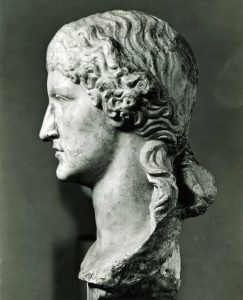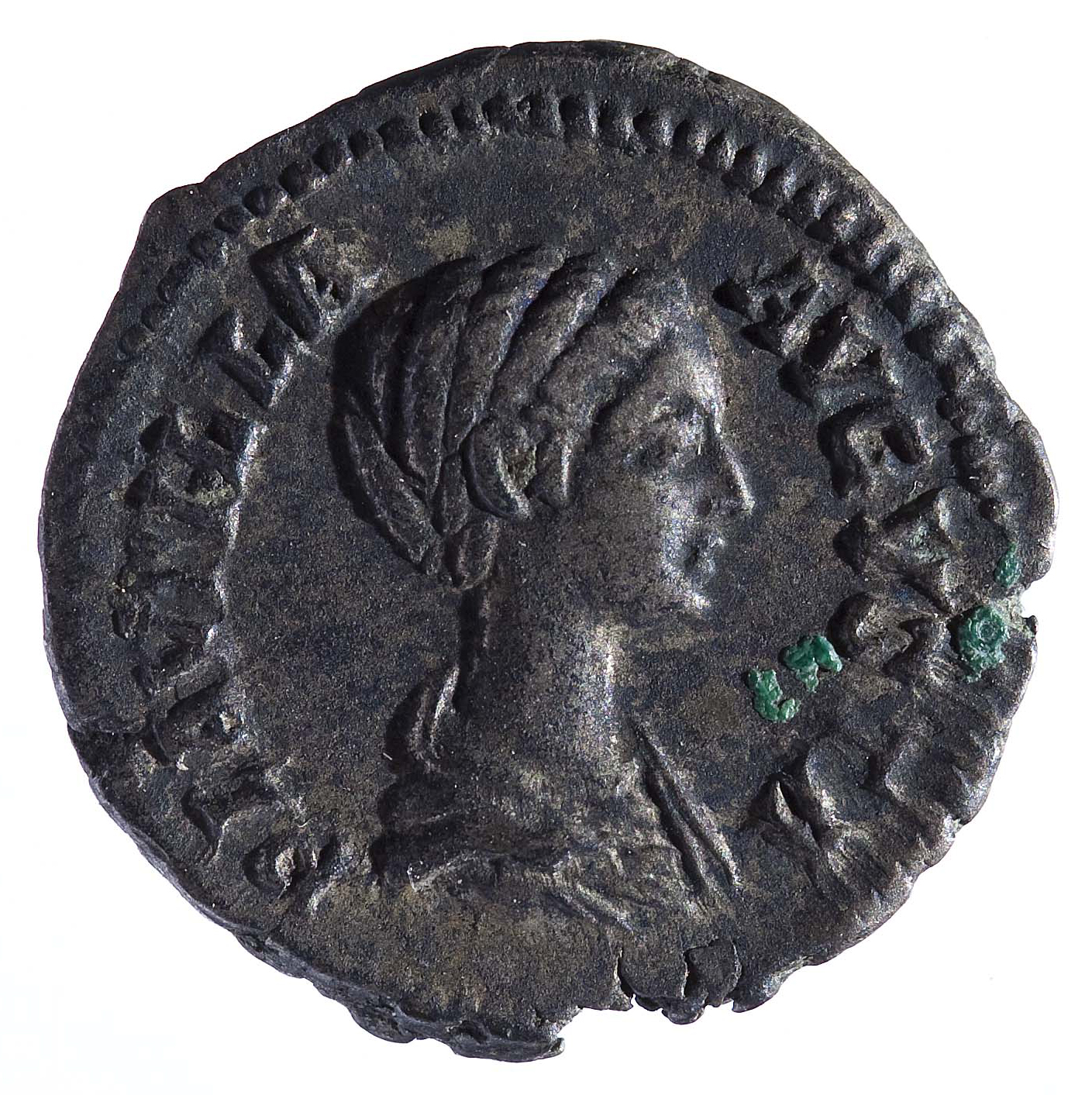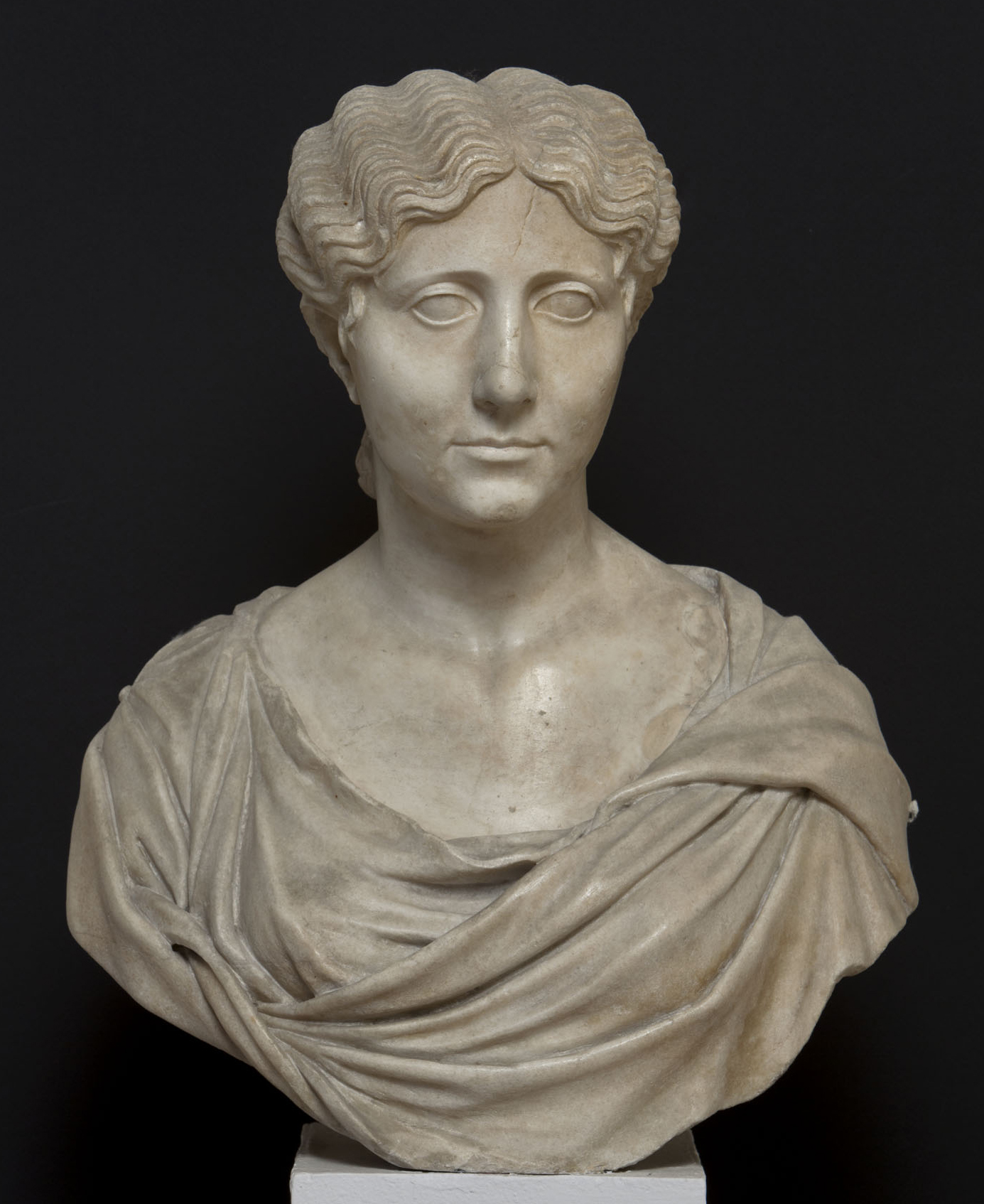
Dominae and fashion: Agrippina the Elder, the perfect matron
Observing the Roman marble portraits in Room IX, one can note the presence of the one belonging to Agrippina Maggiore, an important female character of the Julio-Claudian dynasty. Daughter of Julia and Agrippa, granddaughter of Augustus, wife of Germanicus and mother of Caligula, Agrippina, or rather, Vipsania Giulia Agrippina, was born in 14 BC. At just two years of age, she became an orphan of her father, witnessing the failure of all the political manoeuvres attempted by Augustus for the succession. Forced by circumstances (desired or not) to change plans several times, the princeps then designated Tiberius, who had married Giulia, giving life to a union destined to fail soon.
In this context, Agrippina grew up educated to conform to the dictates of the mos maiorum, but at the same time, received a high-quality education at the behest of Augustus. After having removed her mother, Julia, and once her brothers Gaius and Lucius died, Agrippina married in 5 AD Germanicus, nephew of both Augustus and Tiberius, who was a character potentially eligible for the imperial throne and a man of human and military value. From this union, Agrippina gave birth to six sons (some who died prematurely) and three daughters, according to the Augustan dictates regarding marital prolificacy, so that she was celebrated as an ideal female model: the couple, moreover, was capable of creating thus a blood bond between the two branches of the dynasty.
After the death of Augustus in 14 AD, Tiberius became emperor, while Germanicus was sent to stabilize the Rhenish limes and avenge the defeat of Teutoburg in 9 AD. Agrippina followed her husband and became the protagonist of some episodes linked to her fame: a revolt broke out among the legions of the Rhine, the matron had leveraged her reputation and her little son Caligula to win the sympathies of the soldiers and, consequently, favour her husband’s accession to the throne, effectively orchestrating a possible subversion against Tiberius.
Agrippina, therefore, tried to bring the Rhine legionaries to her side by supporting and inciting them on every occasion, having understood that their discontent with the conditions of enlistment and their political weight could be to her advantage. However, Germanicus did not support these plans, which allowed the definitive recomposition of the revolt, and also the return of political and family tranquillity. Tiberius, however, in 16 AD, called Germanicus back to Rome despite the essentially positive results that he had obtained: given his knowledge of the territory, he decided not to insist on new campaigns and to limit himself to garrisoning the limes so as not to waste other resources, even if according to Tacitus this happened instead because the princeps feared his nephew’s popularity and envied his successes.
The following year, after the celebration of the triumph, Germanicus was sent to Syria, where he collaborated with Calpurnius Piso, newly elected governor of the province: but right from the start, the senator implemented machinations to prevent the young general from being able to gather consensus among the eastern legions. At the same time, Agrippina had to deal with the similar plots of the governor’s wife, Munazia Plancina, in a general delegitimization plan later attributed to Tiberius.
The couple, recipients of various honours, for example in Egypt, had accepted them willingly by establishing ties with oriental dynasties and elites, also with a view to the future inheritance of the empire: Piso and Plancina would therefore have tried to stem manoeuvres and attitudes deemed inappropriate. When in 19 AD, Germanicus fell ill in Antioch, it seems he suspected from the beginning that he was the victim of poisoning by the governor, recommending to his wife, before dying, not to challenge the power of Tiberius to protect himself herself and her children.
After her husband’s death and funeral in Antioch, Agrippina brought his ashes back to Rome in a climate of deep mourning and suspicion towards the emperor. Even the landing in Brindisi would have been orchestrated by the matron to increase, as much as possible, people’s consensus and empathy towards her, underlining her virtue in the act of personally transporting the urn and the lineage directed by Augustus, at the same time placing Tiberius in difficulty; in the same Tabula Siarensis, containing the honours attributed to Germanicus by the Senate, Agrippina obtained a specific mention. Instead, Piso and Plancina, although tried, were substantially relieved of charges.

Protrait of Agrippina Maggiore
The marble portrait in Room 9 depicts Agrippina’s strong personality well: it refers to a typology derived from the one preserved in the Capitoline Museums, adopted both during her life and after the death of the matron. Although idealized and classical, the portrait expressed dignity and melancholy, which were accentuated by the depth of her eyes and also by the inclination of his head. Particular attention must be paid to the hair: the austerity of the costumes dictated by Augustus matched sober hairstyles, well exemplified by the one of Livia. As time passed, these canons gradually communicated less severity: the front knot gave way to hair parted in the centre with wavy locks on the sides, collected in a ponytail over the shoulders. The developer of the first true renewal of the female image was Agrippina Maggiore, whose wavy hair was adorned with curls on the temples (made with the use of the drill) to cover the ears, with partly free locks along the neck and partly tied in a queue. It was an evident reference to classical ideals of beauty, connected to the figure of Venus and her curls, a symbol of wealth and well-being: it was a new fashion, followed both in the imperial dynasty and in private circles, destined to lead towards new, elaborate solutions.
In the years following the death of Germanicus, the faction headed by Agrippina began to weaken with the rise of the praetorian prefect Sejanus: while this fueled suspicions of a plot by Agrippina against Tiberius, the matron gradually saw her supporters thinning out. Increasingly isolated and refused the possibility of getting married again, the emperor’s niece became a victim of Sejanus’ intrigues, so much so that she was accused of immoral behaviour and condemned in 29 AD into exile on the island of Pandataria.
During her imprisonment, she still maintained a proud and dignified attitude, preferring to allow herself to die of starvation despite the mistreatment she also suffered. The news of her disappearance, which occurred in 33 AD, was announced by Tiberius herself, who proposed a negative portrait contrasting with the image previously attributed to Agrippina. Whereas Caligula, once he became emperor in 37 AD, restored his maternal figure’s honour by having her ashes buried in Augustus’ mausoleum.
Michele Gatto
Bibliography
BUCCINO L. 2011, “Morbidi capelli e acconciature sempre diverse”. Linee evolutive delle pettinature femminili nei ritratti scultorei dal secondo triumvirato all’età costantiniana, in E. La Rocca, C. Parisi Presicce, A. Lo Monaco (a cura di), Ritratti. Le tante facce del potere (catalogo della mostra, Roma, Musei Capitolini, 10 marzo – 25 settembre 2011), Roma 2011, pp. 360-383.
KIENAST D. 1996, s.v. Agrippina Vipsania (A. maior), in Der Neue Pauly: Enzyklopädie der Antike, Stuttgart – Weimar, pp. 297-298.
SALVO D. 2010, Germanico e la rivolta delle legioni del Reno, in “Hormos. Ricerche di storia antica” 2, pp. 138-156.
TRAVERSARI G. (a cura di) 1968, Museo Archeologico di Venezia: i ritratti, Roma.
TRILLMICH W. 1994, s.v. Agrippina Maggiore, in Enciclopedia dell’Arte Antica, Roma, pp. 114-115.
VALENTINI A. 2019, Agrippina Maggiore. Una matrona nella politica della domus Augusta, Venezia.




